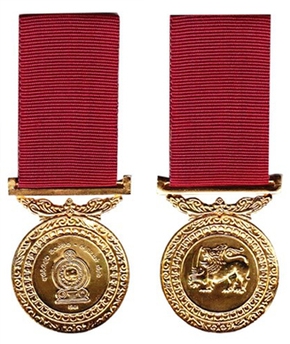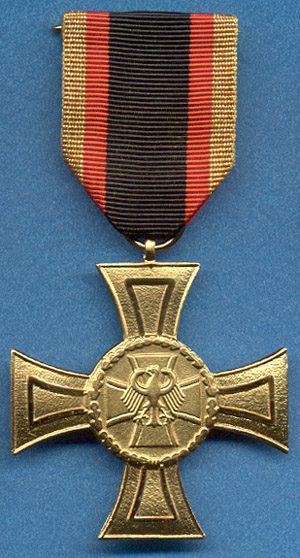The George Cross (GC) is the highest award bestowed by the British government for non-operational gallantry or gallantry not in the presence of an enemy. In the British honours system, the George Cross, since its introduction in 1940, has been equal in stature to the Victoria Cross, the highest military gallantry award. It is awarded "for acts of the greatest heroism or for most conspicuous courage in circumstance of extreme danger", not in the presence of the enemy, to members of the British armed forces and to British civilians. Posthumous awards have been allowed since it was instituted. It was previously awarded to residents of Commonwealth countries, most of which have since established their own honours systems and no longer recommend British honours. It may be awarded to a person of any military rank in any service and to civilians including police, emergency services and merchant seamen. Many of the awards have been personally presented by the British monarch to recipients or, in the case of posthumous awards, to next of kin. The investitures are usually held at Buckingham Palace.

The George Medal (GM), instituted on 24 September 1940 by King George VI, is a decoration of the United Kingdom and Commonwealth, awarded for gallantry, typically by civilians, or in circumstances where military honours are not appropriate.

The Distinguished Conduct Medal was a decoration established in 1854 by Queen Victoria for gallantry in the field by other ranks of the British Army. It is the oldest British award for gallantry and was a second level military decoration, ranking below the Victoria Cross, until it was discontinued in 1993 when it was replaced by the Conspicuous Gallantry Cross. The medal was also awarded to non-commissioned military personnel of other Commonwealth Dominions and Colonies.

The Conspicuous Gallantry Medal (CGM) was, until 1993, a British military decoration for gallantry in action for petty officers and seamen of the Royal Navy, including Warrant Officers and other ranks of the Royal Marines. It was formerly awarded to personnel of other Commonwealth countries. In 1943 a Royal Air Force version was created for conspicuous gallantry in action against the enemy in the air.

The KirtiChakra is an Indian military decoration awarded for valour, courageous action or self-sacrifice away from the field of battle. It may be awarded to civilians as well as military personnel, including posthumous awards. It is the peacetime equivalent of the Maha Vir Chakra. It is second in order of precedence of peacetime gallantry awards, comes after Ashoka Chakra and before Shaurya Chakra. Before 1967, the award was known as the Ashoka Chakra, Class II.

The Indian Order of Merit (IOM) was a military and civilian decoration of British India. It was established in 1837, although following the Partition of India in 1947 it was decided to discontinue the award and in 1954 a separate Indian honours system was developed, to act retrospectively to 1947. For a long period of time the IOM was the highest decoration that a native member of the British Indian Army could receive and initially it had three divisions. This was changed in 1911 when Indian servicemen became eligible for the Victoria Cross. A civilian division of the IOM also existed between 1902 and 1939, however, it was only conferred very rarely.
The Legion of Merit was a Rhodesian order of merit awarded to both civilian and military recipients for service to Rhodesia.

The Parama Weera Vibhushanaya (PWV) is Sri Lanka's highest military decoration, awarded for acts of exceptional valour in wartime. Parama Weera Vibhushanaya translates as the ""Decoration of Supreme Heroism", and the award is granted for "individual acts of gallantry and conspicuous bravery of the most exceptional order in the face of the enemy". Corporal Gamini Kularatne, was the first recipient. As of January 2021, the medal has been awarded 31 times, of which all were posthumous and arose from actions in the Sri Lankan Civil War. Of the 31 awardees, 28 have been from the Sri Lanka Army, two have been from the Sri Lanka Navy and one has been from the Sri Lanka Air Force.
The Star of Gallantry (SG) is a military decoration awarded to personnel of the Australian Defence Force (ADF) and other persons recognised by the Minister for Defence. It is awarded for acts of great heroism or conspicuous gallantry in action in circumstances of great peril. It is the second highest of the military gallantry awards in the Australian Honours System, only surpassed by the Victoria Cross or Victoria Cross for Australia (VC).

The Silver Cross of Rhodesia was Rhodesia's second-highest military decoration for conspicuous gallantry.

The Bronze Cross of Rhodesia was a Rhodesian military decoration for gallantry.

The Grand Cross of Valour was Rhodesia's highest military decoration, awarded for conspicuous valour by members of the Security Forces in combat.
The Independence Decoration was a Rhodesian civil decoration awarded to persons who played a notable and significant part in the Unilateral Declaration of Independence in 1965.
The Police Decoration for Gallantry was a Rhodesian gallantry award. It was awarded for gallantry to members of the British South Africa Police, Police Support Unit, and Police Reserve.
The Police Decoration for Gallantry was a Rhodesian gallantry award. A handful were awarded for conspicuous gallantry to members of the British South Africa Police, Police Support Unit and Police Reserve.
The Independence Commemorative Decoration was a Rhodesian civil decoration awarded to persons who had rendered valuable service to Rhodesia. The award was instituted in 1970 by Presidential Warrant, the first awards being made the same year. Recipients were entitled to the post-nominal letters ICD.

The Decorations of Honour of the Bundeswehr are a series of military decorations of the Bundeswehr, the armed forces of the Federal Republic of Germany. These honours and awards were introduced in 1980 on the occasion of the 25th anniversary of the Bundeswehr by then Minister of Defence Hans Apel and subsequently approved by President of the Federal Republic Karl Carstens.

The Rhodesia Medal was initiated by the British Government in consultation with Australia, New Zealand, Fiji and Kenya, whose forces took part in Operation AGILA. The role of the multi-national force was to keep peace between 22,000 guerrilla fighters and the Rhodesian forces during the ceasefire and run-up to the 1980 elections.

In 1895, Queen Victoria authorised Colonial governments to adopt various British military decorations and medals and to award them to their local military forces. The Colony of Natal introduced this system in August 1895 and, in 1897, instituted the Distinguished Conduct Medal (Natal), post-nominal letters DCM.
The Meritorious Conduct Medal was a Rhodesian military decoration for brave and gallant conduct.













